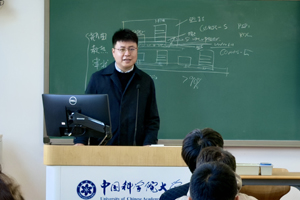光影铸魂忆先烈,初心如磐担使命——现代产业学院20253...
-
山河垂泪,历史昭昭。2025年12月13日,在南京大屠杀死难者国家公祭日设立十一周年、中国人民抗日战争暨世界反法西斯战争胜利八十周年的特殊时刻,现代产业学院20253201党支部在教二114教室举行“铭记历史,守护真相” ...
科学前沿讲座暨卓工名师系列讲堂|第八期:王若达——后摩尔...
-
2025年12月11日上午,中国科学院大学现代产业学院成功举办题为《后摩尔时代集成电路产业发展思考》的科学前沿讲座。本次讲座在雁栖湖校区教二楼138主会场与玉泉路校区阶二1分会场同步进行,特邀中国电子信息产业发展研究院集 ...
传承精神火炬 勇攀科研高峰——现代产业学院2025320...
-
为深入学习贯彻习近平新时代中国特色社会主义思想,增强青年党员的使命担当,推动红色精神与科研实践深度融合,12月18日晚,现代产业学院20253201党支部在教二楼组织开展“传承精神火炬 勇攀科研高峰”主题党日活动。活动由 ...
现代产业学院“校园冬至饺子宴”活动成功举办!...
-
冬至寒意浓,饺香暖人心。12月18日和21日,现代产业学院“校园冬至饺子宴”活动分别在玉泉路校区食堂和雁栖湖校区三食堂圆满举办。食堂内早已备齐雪白的饺子皮、鲜香的馅料和各类工具,活动伊始,食堂的叔叔阿姨们便来到食材区,亲 ...
专家观点


吕本富:发展新质生产力,提高国际竞争 ...
不久前,中国驻美国大使谢锋就“新质生产力”和中国经济形势接受美国《新闻周刊》专访。可以说,自今年年初“新质生产力”成为中国热词之后,美国等西方国家媒体也对这个概 ...

专家观点
吕本富
吕本富:创新如何跨越“最后一公里” ...
创新诚可贵,特别是颠覆性创新在变成技术上可操作的“发明”之前,需要消耗大量的资本,这其中也包括那些悄然沉底的发明所消耗的资本。许多发明在技术上看起来完美,但在商 ...

专家观点
吕本富
吕本富:物联网+区块链会成为第三次创 ...
吕本富认为,如果上链的全部是数字化资产,那区块链对物理世界的影响还是比较小的。但如果加上物联网,意味着一些人的物理财产也通过编码上网, ...

专家观点
吕本富















